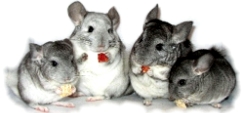
All chinchillas have different personalities, regardless of their size, sex or color. Having one that is human-friendly, should be raised by it's chinchilla mother, but handled by a caring human on a daily basis. Chinchillas have the full range of emotions that humans have. If you plan to, or think you might want to get two in the future, it is best to get them at the same time and of the same sex and close to the same size. This way, you avoid having the problems of trying to introduce two when they get older, only to find out, they do not like each other and will not get along with each other, then you have two lonely chins to care for.
Do you have other chinchillas already, or will this be your first? If you have other chinchillas already and any of them are females, I would get two females rather than 2 males, should you decide to get two. Placing two males in the same cage when there are female chinchillas in the same building, is asking for trouble. Males can spend weeks, months and even years together, without incident. But, sooner or later, a female will come into season that they both want ... even if neither can get to her ... they may fight ... even to the death for what they think will be the right to breed her. It is called 'survival of the fittest', nature's way of insuring the continuing existence of the species. When you find a male mangled and bloody, dead or close to it, you learn never to place two males together when females are present. I know from experience ... one I will never forget and never want to see repeated.
Dwarf chinchillas, like dwarf humans, are physically different than their 'normal-sized' counter parts. The dwarf chinchilla has the head about the size of the normal chinchilla, but it's body is much smaller in comparison and looks out of proportion with it's head. If you have ever seen a kit when it is only a day or so old and the head looks much to large for it's body, this is what dwarf chinchilla always look like.
Please, do not mistake a chinchilla that is very small due to improper breeding or one that was premature and think it is a 'dwarf chinchilla' just because of it's small size. I have seen some breeders unfamiliar with dwarf chinchillas that think that they have a 'dwarf' chinchilla, when it is not. These chinchillas are often, not always fully developed and problems will show up later. I was given a kit that weighed only 80 grams at the age of 8 weeks, because the rancher did not have the time to spend with it that would be needed. I named her Tiny and she only lived 5 months, never reaching even the 200 gram mark. Her hidden birth defect was a thin wall of the uterus. One day, without warning, it ruptured and her intestines prolapsed into her uterus, causing internal bleeding. She has a very special place in my heart. We had her for only a short period of time, but she was a very special little chin.
Do keep in mind, if you do get a female dwarf chinchilla, she can
never be put into breeding, not even with a male dwarf chinchilla. The dwarf chinchilla does have the normal size chinchilla in it's family background. A normal size kit can show up at any time, even from two dwarf chinchillas.
Should a female dwarf chin produce a full/normal size kit, she will probably not be able to deliver it and both will most likely die in the attempted birthing process.
A dwarf male chinchilla can be put into breeding with a normal/full size female chinchilla, but, as a rule, they are not desirable and are not as healthy as normal size chinchillas.
Dwarfism is a defect in the otherwise normal genes of an animal, be it two or four legged.
Hope this has helped you understand dwarf chinchillas and just some of their special needs.

Jo Ann

 Author
Topic: The Realistic and Objective Description of Chin Temperament (Read 2299 times)
Author
Topic: The Realistic and Objective Description of Chin Temperament (Read 2299 times)




